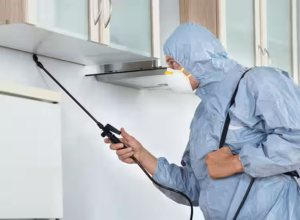Accurate pest identification is the first step in a successful pest control program. This allows you to determine basic information about the pest, including its life cycle and when it is most susceptible to being controlled.
When hiring a pest control company, look for one with experience. Ensure their tenured legacy speaks to their quality of work and customer satisfaction. Contact Trapping USA Animal Removal & Pest Control now!

Pests cause costly damage that can leave lasting marks on your property, health, and well-being. The best and most economical form of pest control is prevention. Pests earn their name as unwelcome visitors when they invade your home, causing harm through a variety of means. They may sting or bite (like bed bugs, ants, cockroaches and cluster flies) or stain or contaminate food, crops, fabrics and personal belongings. They often carry and spread diseases (like roaches, rats, fleas and mosquitoes). Their presence may also trigger allergic reactions in some people.
Preventing pests from gaining access to your home requires a careful look at your property’s entry points and a commitment to keeping them closed. A professional can help you identify potential pest entryways and block them to prevent infestations. Regular inspections of your property’s exterior and interior can help you spot cracks, gaps and holes where pests could enter, so they can be repaired promptly. Use quality sealant or knitted copper mesh to patch these areas. You can also seal up other easy entry points such as vents, drains and utility lines.
Keep your eyes peeled for twigs, leaves and other debris that may be used to build nests by pests like ants or rodents. Remove trash on a regular basis and ensure that your garbage bins have tight-fitting lids. Clean up spills and clutter quickly, and reduce the amount of food scraps left out. Pests have superpowers when it comes to detecting odors, so make sure to store all foods in sealed containers.
Using traps, baits and other devices to target specific pests and remove them from the environment is another method of pest control. These methods may use chemicals to kill the targeted pest, but they should be judiciously applied and disposed of according to their product labels. Be sure to purchase pest control products from a reputable dealer who follows all applicable laws regarding the sale, transport and application of these substances. Never transfer pesticides from one container to another unless the product label indicates that this is safe and necessary.
Suppression
Pest control is the elimination or management of unwanted creatures such as rodents, cockroaches, termites and bed bugs. This is done to protect health, safety and property. Pests can cause serious damage to crops, buildings and the environment. They can also affect human health by spreading diseases. They can also trigger asthma attacks and allergies in some people. It is important to hire a professional pest control expert to ensure that the problem is dealt with in the most effective way.
An effective pest control program starts with accurate identification of the pest. This can be done by trapping or scouting. Scouting involves regularly searching for and identifying pests and assessing the extent of the damage they are causing. The scouting process can help you determine when the number of pests reaches an economic threshold level where the cost of controlling them outweighs their damage.
Physical and mechanical control measures are those that eliminate pests or make their environment unsuitable for entry, dispersal, survival and reproduction. They may involve manipulation of environmental conditions (temperature, humidity, controlled atmosphere), use of barriers or screens, light taps and other devices, sanitation, pheromones, radiation and other techniques. These controls are usually a part of an integrated pest management (IPM) strategy.
Chemicals, including pesticides, insect growth regulators and biopesticides, are often used to control pests. These chemicals may be sprayed directly on or near the pests or in the environment where they live. The types of chemicals that are used depend on the nature and severity of the pest problem. Chemicals that are sprayed directly on or near the crop are called contact sprays. These are less harmful than fumigants, which are pumped into the air.
Fumigants are powerful gases that are pumped into the air to kill or repel pests. These are the most effective methods for eradicating severe infestations, but can be dangerous to people and animals. They can cause respiratory problems and are often banned in public spaces. Alternatives to spraying are baiting and trapping, which work by taking away the pests’ food sources or breeding grounds.
Detection
Pest detection is an important step in preventing and controlling pest infestations. It involves identifying pests and their signs in your home or garden to take preventive measures and alert you if there are any issues. It can be achieved through a combination of visual surveys and pest traps. It is often used at high risk locations such as orchards and apiary yards that receive imported fruit; roadside rest areas with weed and Red Imported Fire Ant infestations; crop production fields to detect new pests that may threaten the state’s ag industry.
Various AI methods have been developed to improve the efficiency and accuracy of pest detection. In particular, the use of neural networks (NNs) is a prominent trend in this field, as they are capable of detecting various pests in images and can perform well even on unlabeled data. Furthermore, these models can be adapted to different environments and specific pests. However, the development of a robust pest detection system requires significant resources and expertise.
Many of the latest NNs for pest identification and monitoring use multiple models in ensembles to provide more accurate predictions (LeCun et al., 2022). This approach leverages the strengths of individual models to compensate for their shortcomings and enhance overall performance. The resulting multi-network-based systems are able to outperform previous state-of-the-art algorithms.
For example, an ensemble of a supervised deep learning model with feature concatenation and SVM classifiers outperformed six state-of-the-art NNs in an insect classification task (Ayan et al., 2020). Other ensemble methodologies include a majority voting approach with Feature Concatenation and a full feature fusion mechanism for recognizing multi-scale objects (Turkoglu et al., 2022).
In addition to the use of multi-network-based systems, innovative modified architectures and explainable AI techniques are also key trends in improving the accuracy of NN-based pest detection systems. These approaches seek to enable users to understand how a specific prediction was made, thus enabling them to interpret and use the results.
Lastly, the use of wireless acoustic sensors is a promising solution for detecting insects in agricultural fields. These devices attract insects with pheromones and send images to a cloud server, which can then be analysed and interpreted by farmers to identify the presence of pests. This enables them to focus their pest control efforts in the most effective areas, minimizing the amount of chemicals needed to ensure crop quality.
Treatment
Pests can cause damage to homes and businesses in many ways. They may chew wood and linens, contaminate food and irritate skin. They can also spread disease to humans, animals or plants. Some pests have a fearsome or grotesque appearance, like spiders, silverfish and earwigs; bite or sting, like bed bugs, fleas and wasps; or smell bad, like mice and rats. Others carry and spread diseases, like cockroaches, rodents and mosquitoes.
Treatment is the use of chemicals or other methods to kill or control pests. It is usually a last resort when non-toxic methods have failed. It involves searching for and identifying the pests, understanding their habits, and choosing the best way to control them. It also includes monitoring and evaluating the property for pests once actions have been taken or an area has been treated to ensure they don’t return. Only trained and qualified pest control specialists should handle or apply pesticides.
Integrated pest management (IPM) is the most efficient and environmentally sound approach to pest control. It relies on prevention, suppression, and eradication. Preventive steps include:
- Removing sources of food, water, and shelter.
- Fixing leaky plumbing and preventing moisture.
- Sealing cracks and crevices.
- Keeping garbage in tightly covered containers.
Regularly removing garbage and cleaning up scraps and fallen leaves reduces pest populations.
Suppression is reducing pest numbers to an acceptable level. It is often combined with prevention in outdoor pest situations. Eradication is rare, but it may be possible in some indoor situations, such as the Mediterranean fruit fly and gypsy moth.
Mechanical controls are traps, barriers and fences that prevent pests from entering or spreading into an area. Physical controls can also alter the environment in order to suppress or eliminate pests, such as adjusting humidity or using radiation.
Biological pest control uses natural enemies of the targeted organism, such as predators, parasites and herbivores. It may involve breeding these natural enemies and then releasing them into the environment in small, repeated batches or in a single large-scale release. It can be an important component of IPM programs, especially for horticultural pests.


